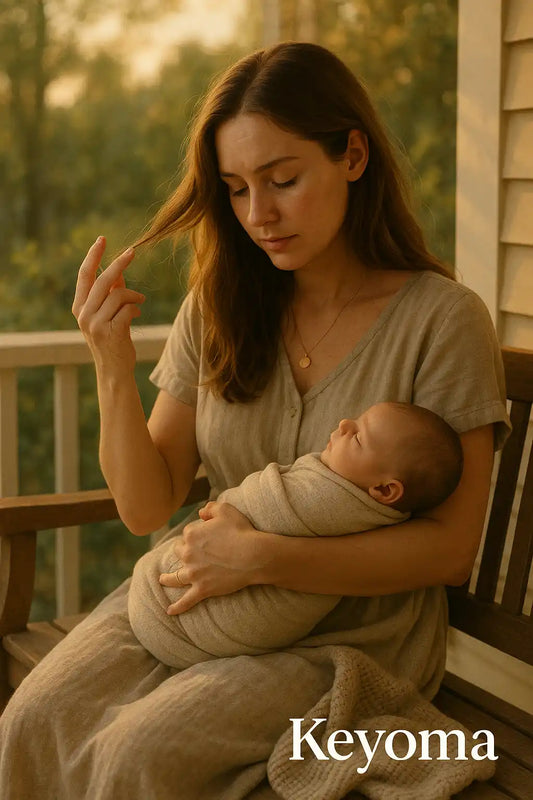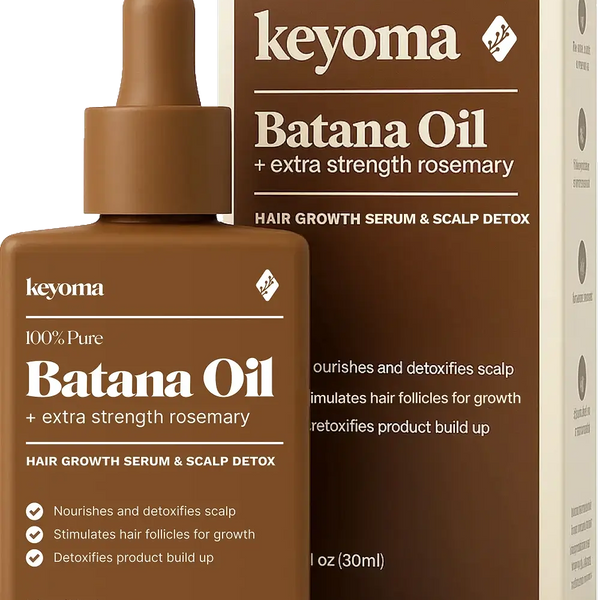In this article
You just brought a new baby into the world. That is no small thing. You deserve all the rest and credit in the world.
But now your hair is falling out? It feels unfair—but it is completely normal. According to the American Pregnancy Association, about 40 to 50 percent of women experience postpartum hair shedding.
The good news is that you can do something about it. With the right care and a little consistency, your hair usually grows back and regains its fullness over time.
Why Hair Loss Happens After Pregnancy
Hair grows in cycles, moving through three main stages: anagen, catagen, and telogen.
The anagen phase is the growth stage. Around 85 to 90 percent of your hair is in this phase at any given time. Then comes the catagen phase, a short transition that lasts about two to three weeks. Growth slows down during this stage as the hair prepares to stop.
Next is the telogen phase, when hair goes into rest mode. This is when shedding occurs. About 10 to 15 percent of your hair follicles are in this phase at once. So the strands you see in your brush or shower drain each day are usually part of this natural process.
Postpartum hair loss, also known as postpartum telogen effluvium, often kicks in two to six months after childbirth. During pregnancy, estrogen levels rise to help support your baby. But after delivery, those levels drop sharply. That sudden shift sends more hair into the telogen phase all at once, which is why shedding can seem intense.
And stress can make it worse. Physical and emotional strain—both common around childbirth—can also trigger telogen effluvium, making postpartum thinning feel even more noticeable.
When Postpartum Hair Loss Usually Starts
If you catch yourself holding your breath while combing your hair, you are definitely not the only one. Postpartum hair shedding does not arrive on a set schedule. For some, it kicks in as early as the first month. For others, it shows up later, sometimes closer to six months after delivery.
But for many, hair starts thinning around the three-month point. You might notice it near the temples or at the crown—those are common spots. And while it can feel unsettling, this phase is normal.
How Hormones Change Your Hair Growth
Hormonal shifts play the biggest role in both pregnancy hair changes and postpartum shedding.
While pregnant, your elevated estrogen levels slowed your regular rate of hair fall. Normally, you shed small amounts daily. But during pregnancy, that shedding rate drops. More blood flow and better circulation also help your strands stay in place longer.
Once your baby arrives and hormone levels drop, your hair starts catching up. You’ll shed in larger amounts—not because you’re losing more than usual, but because it’s happening all at once.
This shedding can begin anytime after childbirth and sometimes lasts up to a year. It often peaks around four months in. If your baby’s a few months old and your hair still comes out in clumps, don’t panic. It’s part of the process.
Learn how to naturally grow your hair
How Long Postpartum Hair Loss Lasts

Wondering how long postpartum hair shedding actually lasts? You are not the only one. The reassuring news is that this phase is temporary.
Shedding usually reaches its peak around the third or fourth month after giving birth. After that, it tends to slow down. You may start to notice fewer strands in your brush or less hair collecting in the shower drain.
And while it can be stressful to see so much hair fall out, try to keep in mind that your body is adjusting. Most people see their hair return to its pre-pregnancy state somewhere between six to twelve months.
The best thing you can do right now is stay patient. Your hair is finding its balance again, little by little.
How to Reduce Hair Loss After Pregnancy
You can’t fully stop postpartum hair loss, but you can take steps to limit it.
Start by taking prenatal vitamins early—before conception, throughout pregnancy, and after giving birth. These nutrients support both your body and your hair.
Reducing stress after delivery can also help. Plan ahead to ease the pressure. Line up a lactation consultant if you expect breastfeeding challenges. Build a support system so you’re not doing everything alone.
You can also practice stress relief through yoga, eating balanced meals, and getting help caring for your newborn.
According to the American Pregnancy Association, these habits may reduce the amount of hair you lose after childbirth.
-
Eat more fruits and vegetables. Their vitamins and minerals help protect your follicles and support healthy hair growth.
-
Skip tight styles. Pulling your hair into braids, weaves, cornrows, pigtails, or using tight rollers puts strain on your strands.
-
Handle wet hair with care. Use a soft towel and avoid rough brushing.
-
Choose the cool setting on your blow dryer to prevent heat damage and protect your scalp.
Discover the benefits of Batana Oil
FAQs
How does pregnancy affect your hair?
You might see differences in how your hair and nails feel and grow while pregnant. Some of us notice quicker growth and stronger strands or nails. Others experience shedding and splitting once the baby arrives. It's normal for most women to lose some hair after giving birth.
How long does hair fall out after pregnancy?
Postpartum hair shedding typically stops within 6 to 12 months after childbirth. As your hormones balance out and return to pre-pregnancy levels, your hair often regains its usual fullness.
Will my hair go back to normal after pregnancy?
Many new mothers go through heavy hair shedding after childbirth. Shedding often hits its highest point around four months postpartum. By the time your baby turns one, your hair usually returns to its regular growth cycle. If it still feels thin after a year, consider visiting a dermatologist.
Start Your Postpartum Hair Recovery With Keyoma
Hair loss during pregnancy—though not widespread—is a typical response to shifting hormones or medical issues. In most cases, your hair starts growing again over time or once the underlying problem is treated.
Postpartum shedding usually peaks about four months after delivery. Most of us see growth bounce back between six and nine months—often before our baby’s first birthday.
If your hair keeps thinning or new symptoms show up, check in with your doctor. You could be dealing with conditions like alopecia areata or androgenic alopecia.
Want a natural place to begin? Start with Keyoma Batana Oil—your scalp will thank you.
Featured Product
100% Pure Batana Oil + Rosemary









